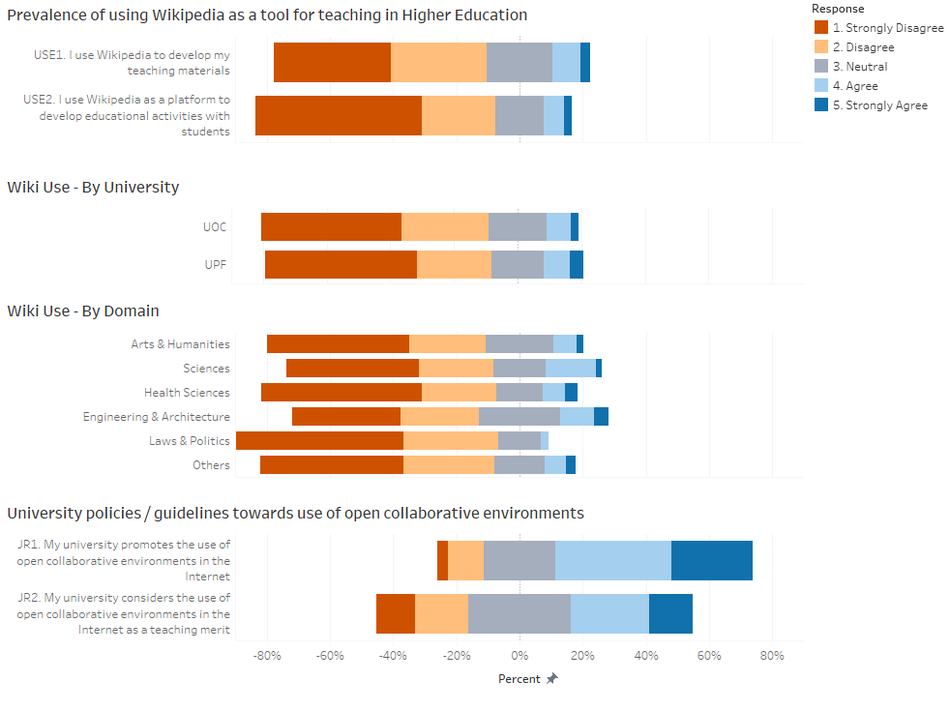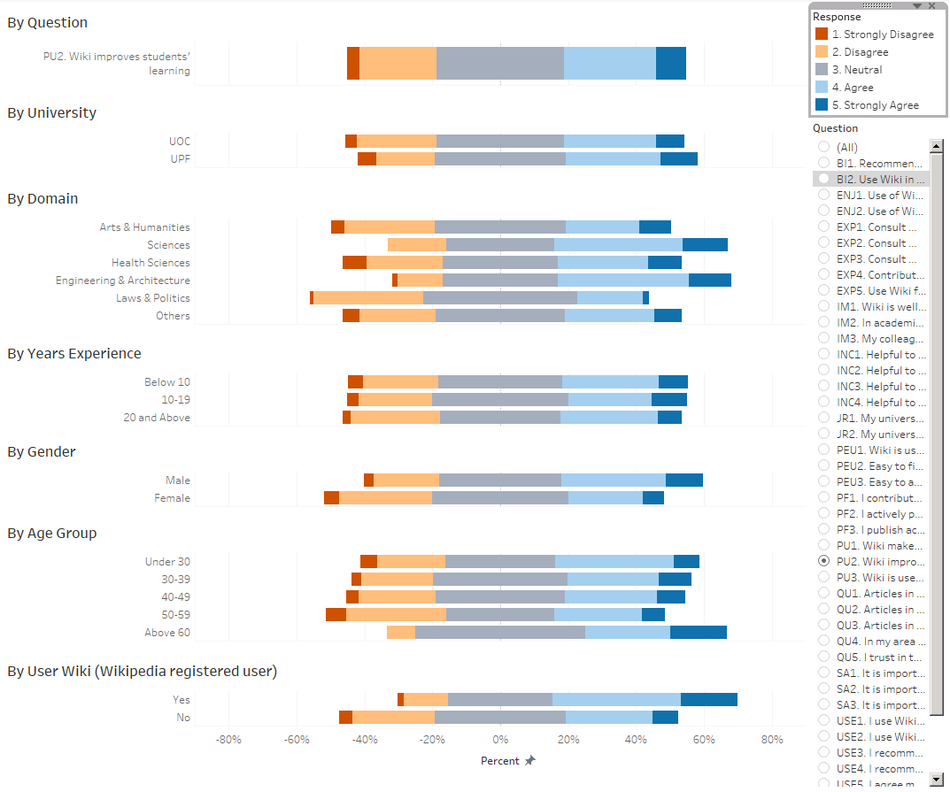ISSS608 2016-17 T1 Assign2 Wesley Chan
Contents
Introduction
While the use of Wikipedia among the general public is well documented, in this study we explore the use of Wikipedia amongst University faculty members as a tool for teaching in Higher Education. This study has two objectives: (i) to understand the factors that influence the use of Wikipedia in Higher Education and (ii) to understand what factors might shape their disposition towards the use of Wikipedia as a tool for teaching in Higher Education.
Wikipedia as a tool for teaching in Higher Education
In this context, we will investigate the following questions:
- How prevalent is the use of Wikipedia as a tool for teaching in Higher Education? Does the adoption rate differ across university and faculty / domain?
- Do demographic factors influence the perceived usefulness of Wikipedia as a tool to improve students' learning in Higher Education?
- What are the factors that might shape academician's disposition towards the use of Wikipedia as a tool for teaching in Higher Education?
The idea is to gain insights into factors that influence and shape academicians' disposition towards the use of Wikipedia as a tool for teaching in Higher Education. The insights from this study can be useful to help universities and academicians improve the adoption of Wikipedia as a tool for teaching in Higher Education.
Dataset
Our dataset is obtained from survey responses to understand the factors that influence the teaching use of Wikipedia in Higher Education in Spain from the Journal of the Association for Information Science and Technology article (Meseguer, Aibar, Llados, Minguillon, Lerga, 2015). A survey of 913 faculty members from two Spanish universities - Universitat Oberta de Catalunya ("UOC") and Pompeu Fabra University ("UPF") were conducted to empirically understand what underpins faculty member's use of Wikipedia. Participants were asked whether they "Strongly Disagree", "Disagree", "Neutral", "Agree" or "Strongly Agree" to a set of 43 questions. Participants were also asked to complete a set of 10 questions requesting information on their demographic background.
Data preparation
We used Tableau 10.0 as our primary tool for re-shaping and re-coding the dataset. We, however, used Excel in order to create a new column to insert set of unique ID for each records, prior to importing the dataset into Tableau. We re-shaped the data in Tableau and recoded the variables e.g. Gender to Male and Female (instead of code 0 and 1), PU1 to "PU1. The use of Wikipedia makes it easier for students to develop new skills" to provide more context to the variable etc. We also recoded "6" in the Domain variable to "Others". For the variables Age and Years Exp, we created age and/or years experience band to aid our analysis. The metadata used for the analysis is provided together with the dataset. (https://archive.ics.uci.edu/ml/datasets/wiki4HE).
The dataset comprised a total of 913 individual records. There were 10 variables representing demographic information including Age, Gender, Domain, Education, Years of university teaching experience, University, Academic position, and whether the participant was a registered user of Wikipedia. We detected some missing data in the demographic dataset and remove those pertinent records with missing data in Domain and Userwiki. To note that there were missing data / responses in UOC Position, Other Position and Other Status, but as these data were not crucial for our analysis, we retained those data sets for analysis.
There were 43 likert-scale (1-5) type questions grouped into the following broad categories: Perceived Usefulness, Perceived Ease of Use, Perceived Enjoyment, Quality, Visibility, Social Image, Sharing attitude, Use behaviour, Profile 2.0, Job relevance, Behavioral intention, Incentives and Experience. All the questions had missing responses, ranging from 4 records for PEU1. Wikipedia is user-friendly to 117 records for VIS1. Wikipedia improves visibility of students' work. We decided, on balance, to retain those records as those missing records are not pertinent to our study and/or would not materially impact our analysis. We are using the percentage of respondents who agree or disagree to a question for the purpose of our analysis.
We decided to retain and import all the variables into Tableau even though they may not be that relevant to our question at this point in order to allow exploration and uncover any unexpected pattern and/or relationship between variables.
Data analysis through visualisation
We explored several visualisation techniques and tools (e.g. parallel coordinates on High-D, mosaic plots on JMP) for our analysis, but we eventually decided to use the divergent bar charts in Tableau as our primary visual analytics techniques for this study. The divergent bar chart is well suited for likert-scale type of questions which is common in opinion survey and market research as we are able to visually see the level of agreement or disagreement and compare the percentage within subgroups.
Under the divergent bar chart, the percentage of participants who agreed with the statement are shown to the right of the zero baseline in one colour, while the percentage of participants who disagree with the statement are shown to the left of the bar / row in a different colour. The level of agreement viz. "Agree" and "Strongly Agree" are coded from light to dark blue, grey for neutral - respondents who neither agree nor disagree are split equally between the zero baseline and orange and brown for "Disagree" and "Strongly Disagree" respectively. We opted to change the Tableau's default colour palette for the divergent bar chart to the brown-orange-blue colour blind palette.
Analysis and Findings
(i) Wikipedia usage as a tool for teaching in Higher Education
For this analysis, we looked at the participant's response to the following questions "USE1. I use Wikipedia to develop my teaching materials" and "USE2. I use Wikipedia as a platform to develop educational activities with students".
Observations
- Almost 70% of the respondents strongly disagreed or disagreed with the use of Wikipedia as a platform for teaching in universities, while only 10% of the respondents agreed or strongly agreed with the use.
- This observation was consistent across both the UOC and UPF University.
- Academics from the Laws & Politics faculty are staunchly against the use of Wikipedia as a tool for teaching in Higher Education.
- The above findings were despite the fact that the university actually promoted the use of open collaborative environments in the internet and as a teaching merit (in the words of the respondents to questions on Job Relevance).
Click on the link below for the visualisation:
(ii) Perceived usefulness of Wikipedia as a tool to improve students' learning
For this analysis, we looked at the demographic profile of those participant who agreed or disagreed to the following question on the perceived usefulness of Wikipedia "PU2. The use of Wikipedia improves students' learning". Note that the x-axis range within each panel have been fixed to the same scale so that each panel has a common zero baseline, which allowed for easier comparisons across the panels. We showed the demographic profile as a coordinated set of divergent bar charts.

